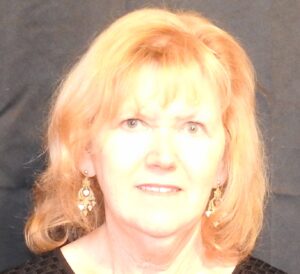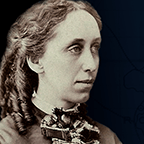Talking About Women’s History: Three Questions and an Answer with Nancy Kopp
Attorney and author Nancy Kopp is part of a two-woman team with an unusual women’s history project. They researched Lavinia Goodell, the first woman lawyer in Wisconsin, and created a website to tell her story.
Nancy grew up on a dairy farm about 10 miles from Janesville, Wisconsin. After graduating from a Milwaukee business college, she got a job as a legal secretary in Janesville. She has always enjoyed research and writing, and she discovered that she loved the law – which requires doing a lot of both – so she went back to school. She has a B.A. in history from the University of Wisconsin-Whitewater and a J.D. from the University of Wisconsin law school. She was in private practice at a large law firm for a few years but for many years has been employed by the Wisconsin Supreme Court as a Supreme Court Commissioner. Years ago she wrote five legal mysteries that were published as paperback originals by Penguin Putnam. She lives in Madison, Wisconsin and loves to travel – most often to historical sites, including many associated with Lavinia Goodell.
Take it away, Nancy!
What path led you to Lavinia Goodell? And why do you think it is important to tell her story today?
I first learned about Lavinia Goodell many years ago – before I went to law school – when I was working as a legal secretary in Janesville, Wisconsin. I was very surprised to discover that a Janesville woman had become Wisconsin’s first woman lawyer. The article I read referenced Wisconsin Supreme Court Chief Justice Edward Ryan’s condescending 1876 opinion refusing to allow Lavinia to appear before the court. I found the decision in our law office library and was infuriated to read that Ryan had denied Lavinia’s petition because, in his opinion, “the law of nature destines and qualifies the female sex for the bearing and nurture of the children of our race and for the custody of the homes of the world and their maintenance in love and honor. And all life-long callings of women, inconsistent with these radical and sacred duties of their sex, as is the profession of law, are departures from the order of nature; and when voluntary, treason against it.” Fortunately Lavinia did not take Ryan’s decision sitting down. She persuaded a male Janesville attorney, who also happened to be a member of the legislature, to introduce a bill changing Wisconsin’s statute to make clear that the legal profession was open to both sexes. That bill passed and was signed into law by the governor in 1877.
Since then I have thought of Lavinia as somewhat of a kindred spirit, and I have always felt that I – and all other women lawyers in the state – owe her a huge debt of gratitude for opening the profession to us. When a friend contacted me in 2018 to ask if I would be interested in doing more in-depth research on Lavinia, I jumped at the chance. I think it is important to tell Lavinia’s her story today to remind people, especially young women, that we all stand on someone else’s shoulders and no matter our profession or avocation might be, we are all benefiting from the hard work and perseverance of so many women who came before us. There are still many glass ceilings to be broken and many societal attitudes that need to be changed before women are truly viewed as equal to men in all walks of life. But hearing stories about women like Lavinia, who overcame enormous obstacles and prejudices to achieve their goals, might give young women today who are being told they ought to “stay in their lane” the grit they need to ignore the naysayers and keep going.
What do you find most challenging or most exciting about researching historical women?
I have found that the most challenging things about historical research are the astonishing amount of erroneous information that is available online and trying to decipher nineteenth century cursive script. These two issues converged when twentieth century folks began to digitize and catalog information. Misspellings of proper names are inevitable, and this presents a real challenge for a researcher. I have seen Lavinia’s name spelled Lavina, Lavona, Lavena and her last name also misspelled in multiple ways. Even the Wisconsin Historical Society’s death record index spelled her name wrong. I learned early on to approach every search using alternate techniques and multiple spellings. When trying to pinpoint where Lavinia lived and worked and the placement of various businesses that she frequented, I also discovered that many cities, including Janesville, Wisconsin, changed street names and renumbered buildings several times, the last time around 1915. In the 1870s, the Goodells lived at 29 South Academy Street. In order to determine the present day location of the house, I had to go through multiple Janesville City directories looking for families who lived on South Academy in the 1870s and still lived there in 1915. It took many hours, but I eventually determined that the Goodell’s house is now numbered 168-170 South Academy. Most articles about 1870s Janesville are unaware of the address changes, meaning that people looking for old sites go to the wrong place. In 2021 I developed two Janesville walking tours that take people past sites that played a role in Lavinia’s life and made sure to note the current location.
Reading 150 year old documents also requires enormous patience. The most frustrating document I encountered was four pages of notes from a court hearing after Lavinia died in which the people who witnessed her will testified about her state of mind at the time she signed the will. The court clerk must have scratched the notes down very quickly with a fountain pen. When I first looked at the document I could only make out a few words on each page. I had to go over it countless times before I finally figured out most of what it said. (There are still a few words that are a mystery.) Over time I became very familiar with Lavinia’s handwriting and her colloquial expressions. Her father, on the other hand, was born in 1792, and his script is exceedingly difficult to read.
I think the most exciting thing about historical research is making an unexpected, sometimes almost serendipitous find. We had known that during the Civil War, Lavinia helped her father publish an anti-slavery newspaper called the Principia. During one of my visits to Berea College in Berea, Kentucky, where the Goodell family papers are housed (because Lavinia’s nephew William Goodell Frost was the longtime president at Berea) I discovered that Lavinia had written dozens of articles and poems for the paper. I was able to access all of the issues of the Principia online and found her articles. That was a thrilling discovery. I doubt that anyone had read them in the last 140 years, but we are now sharing them on our website.
What was the most surprising thing you’ve found doing historical research for your work?
The most surprising thing I found came to light early in my research, and it is that the photograph of Lavinia Goodell that was featured in all previous articles and books mentioning her was not her at all. In the fall of 2018, through ancestry.com, I was able to make contact with several descendants of Lavinia Goodell’s eldest nephew. Virtually the first thing they told me was that back in 1959 one of their relatives had been asked for a photo of Lavinia and he sent off a picture of someone else. His daughter, Sarah Stamps of Nashville, Tennessee, who just died last year at age 95, saw the photo when it was returned and told him, “That’s not Lavinia.” The man responded that he was aware of that but said his photo of the real Lavinia was in poor condition and “This is a better looking woman anyway.” Ms. Stamps was a bit uneasy about the mix-up but she was busy raising a young family and decided the photo was unlikely to ever be disseminated so she did not try to correct the error at that time. Many years later Ms. Stamps was doing some family research online and, to her horror, she discovered that the picture of the “Faux Lavinia” was everywhere, including on a large plaque honoring Lavinia that had been installed in the Rock County Courthouse in Janesville, Wisconsin in 2000. Ms. Stamps and another relative made some efforts to correct the record but soon discovered that once erroneous information is on the web, it is very difficult to change it. Lavinia’s relatives were very pleased that we were researching their ancestor and urged us to try to “give her her real face back.” One of the most gratifying parts of our research project was doing just that. Through our website, social media accounts, and media accounts we have featured what we call the “case of mistaken identity,” and in December 2021, a new plaque bearing Lavinia’s true image was installed at the Rock County Courthouse. We would love to identify the woman in the “faux” picture. With assistance from another Lavinia relative, we have a good idea who it might have been but so far have not been able to definitively prove it. I have not given up on this quest and hope to be able to declare the case closed at some point.
A question from Nancy: My research over the last five years has focused largely on the time period from 1855 to 1880. Are there one or two women from that era that you particularly feel should be better known and why?
The thing that has caught my attention from the period is a type of institution that served women rather than an individual woman. American industrialists founded schools of design for women in northern cities in the decade or two before the Civil War. The curriculum was designed to train women in textile and wallpaper design, wood engraving, and other marketable artistic skills. It wasn’t a purely philanthropic endeavor. Textile mill owners, for instance, wanted to produce homegrown talent to replace the expensive designs they previously purchased from France. I want to know more about the women who attended these schools and what they did after they graduated.
***
Want to know more about Lavinia Goodell?
Check out the website: www.laviniagoodell.com.
Like the Facebook page: https://www.facebook.com/LaviniaGoodell
Follow her on Instagram: @laviniagoodell
***
Tomorrow it will be business as usual here on the Margins with a women’s-history- related blog post from me. But we’ve still got more people talking about women’s history from a lot of different angles next week. Don’t touch that dial!






